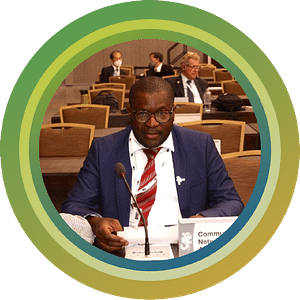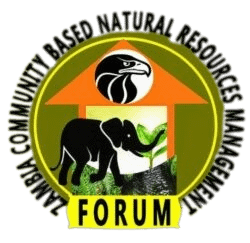Why is governance critical in effective Community-based natural resources management (CBNRM) programs in Zambia?

Dr. Rodgers Lubilo- Board Chairperson
Introduction
This policy brief is targeted at the Zambian government, local communities, stakeholders,
and civil society organizations that are involved in community-based conservation initiatives in
the country. It is aimed at providing the linkage between governance and community-based
natural resources management (CBNRM). The brief unpacks the concept of CBNRM, how it
works, and the purpose it intends to achieve. It brings out how CBNRM functions in practice
and shows the power relationship, and more especially how governance shapes its performance.
What is CBNRM? And why is it relevant
Community-Based Natural Resources Management is the process of devolving management
responsibilities of natural resources into the control of the Indigenous Peoples and Local
communities who reside and interact with the wildlife resources. CBNRM is premised on the
belief that the people who live with wildlife and other natural resources will better manage them
if they can derive some form of benefits. Specifically, this approach brings about some of the
following elements;
▪ It creates institutions at the community level to manage natural resources;
▪ It promotes co-management, partnership, and collective resource ownership;
▪ It creates processes for incentivizing local communities to access, and benefit from
sustainable utilization of these resources;
▪ It promotes the democratization of community governance through an open and
accountable system;
▪ It contributes to capacity development, raises awareness of rights, and strengthens the
political constituency of the communities.
▪ It set in motion processes of community-led biodiversity conservation, and rural
development and increases opportunities for local livelihoods.
At most CBNRM is centered on the recognition of local communities’ rights, owning the
resources, assuming management responsibilities, and being able to distribute benefits, achieving
the dual role of conservation and empowering local communities with opportunities to improve
their lives. CBNRM provides an economic framework for making natural (wild) resources
valuable to the people who produce them. It is a global project that has received international
recognition and requires commitment by various actors including government, civil society, and
local communities alike.
Overtime decades, the implementation of CBNRM has been overshadowed by poor
governance, limiting its ability to deliver on the promised hope.
CBNRM governance structures
CBNRM has created local-level governance structures, for implementing its activities,
these include structures: – Village Action Groups (VAGS), Community Resources Boards (CRBs),
Community Forest Groups (CFMGs), Village Fisheries Management Committees (VFMCs), and
several other community-based organizations that have been established as a response to
implementing community-led conservation. These institutions set in motion the governance
framework for people’s participation and enhance prospects for accessing benefits. Various pieces
of legislation and policies from wildlife, forestry, and fisheries among others recognize the rights
of the local communities to participate in the management process of these resources.
What is governance and its importance?
Governance is a mechanism in which CBNRM structures, organize themselves, to participate
and deliver on the expectations; specifically,
▪ Governance is about taking decisions and ensuring the conditions for their effective
implementation.
▪ It is the process of developing and exercising authority and responsibility over time.
▪ It is about who takes decisions, and how, including in relation to learning processes and
evolving institutions in society.
▪ Is the process of interactions among structures, processes, and traditions that determine
how power and responsibilities are exercised?
▪ It is about the formal rules (policies, procedures) and the informal rules (norms, values,
customs, traditions)
▪ It is about who holds power, authority, and responsibility and who is, or should be, held
accountable.
It is obvious that good governance in CBNRM will assist in improving the delivery of the promise
of the approach;
▪ It will ensure that the decision-making process is participatory, transparent, and
democratic and that these decisions are initiated by the local communities themselves;
▪ It ensures that the system and the leadership are accountable to the community
structures, government, and other partners.
▪ It strives towards giving communities more power over other actors and players in the
community-led conservation
▪ It creates incentives for the communities to continue to play stewardship roles in resource
governance.
So, governance is central to the success of CBNRM because it helps define the management
system, allocate rights, roles, and responsibilities, and brings out systems of making decisions and
allocation of resources to beneficiaries. When good governance is lacking or weakened, we often
see CBNRM crumbling, it gets resented and results in dismal performance. Zambia’s CBNRM
continues to face governance challenges especially, due to the lack of a National Policy to guide
the government and other stakeholders on how to be able to account for their actions
What is being done to improve governance
As noted already, the major threats to the effective performance of CBNRM are
governance, as it should provide a clear framework of who owns what, who has the power to
decide, who should be benefiting, etc. In order to address these governance lapses or omissions,
various interventions are taking place in the industry. On its part, Zambia CBNRM Forum,
through a global partnership with International Institute for Environment and Development (IIED)
with funding from European Union, through International Conservation Union (IUCN) is funding
a Biodiversity Protected Area Management (BIOPAMA) programme. Through, this support the
Forum has been implementing a project entitled ‘Enhancing Governance in Community-based
Natural Resources Management to achieve social and conservation outcomes in Mumbwa,
Namwala, and Mufunta Game Management Areas (GMAs) of Kafue Landscape, and Chiawa,
Rufunsa and Luano GMAs in the Lower Zambezi/Luangwa landscape. Using various governance
assessment tools such as the Site Level Assessment for Governance and Equity (SAGE) and
Governance Assessment of Protected Areas (GAPA) to identify key governance challenges and
also suggested actions to address the gaps. The project has assisted in improving stakeholder
collaboration, information sharing, capacity training for community and stakeholders, and
improving the application of fairer law enforcement through capacity training to the community
scouts and other law enforcement offices in the targeted GMAs. It empowered the community
governance structures with minimum skills to effectively preside over the affairs of community
conservation. A national CBNRM Learning Group (CLG) has been set up to work as a thinking
and advisory body on better-managed CBNRM in the country. It is also thrilling to note that the
government has approved a National CBNRM policy, and we believe this will enhance the
performance of CBNRM governance in the country. This process should be followed by enacting
relevant laws to help enforce the policy implementation.
Conclusion
CBNRM in itself is a governance mechanism for empowering the Indigenous Peoples and
Local Communities (IP&LCs) in their stewardship to look after the natural resources, manage
them wisely, and then be able to make their own decisions on the utilization of these resources.
Often, weak and prohibitive legislations and policies, have denied the IP & LCs the necessary legal
framework to fully take control of the process. The improvement in the performance of CBNRM
is largely linked to governance because all processes, of resource ownership, benefit distributions,
decision-making, and the sustainability of the structures all fall within the governance framework.
It gratifying that Zambia is making progress in addressing the governance gaps and the Forum and
the broader CBNRM Association will continue to engage with government and stakeholders in
pursuing an agenda to ensure that CBNRM is beneficial to all.
For any inquiries please write to Dr Rodgers Lubilo @ rlubilo288@gmail.com and Ms. Cecilia
Banda @ ceciliadbandah@gmail.com
